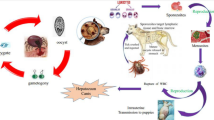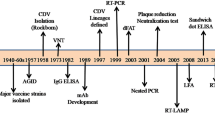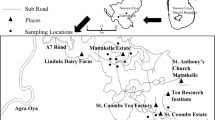Abstract
Trypanosoma evansi is a widespread and neglected zoonotic parasite that affects domestic and wild animals, causing a disease commonly known as “surra.” The Brazilian Pantanal wetland is recognized as an enzootic area for this protozoan, yet recognizing the importance of reservoir hosts also in order to prevent zoonotic outbreaks. This study aimed to assess the occurrence of T. evansi in jaguars (Panthera onca) from the Brazilian Pantanal wetland and explore associated clinical and hematological manifestations. A total of 42 animals were screened by PCR and sequenced for species identification when positive. Trypanosoma evansi was detected in six free-ranging jaguars (six positive animals of 42 captures and 16 recaptures), representing the first molecular evidence of such infection in this animal species. Our findings suggest that jaguars may act as reservoir hosts of T. evansi in the Brazilian Pantanal wetland. The better understanding of the role of wildlife in the epidemiology of T. evansi is also of importance to future reintroduction and translocation programs toward wildlife conservation efforts.

Similar content being viewed by others
Data availability
No datasets were generated or analyzed during the current study.
References
Aldana-Domínguez J, Forero-M J, Betancur J, Cavelier J (2002) Dinámica y estructura de la población de chiguiros (Hydrochaeris hydrochaeris: rodentia hydrochaeridae) de Caño Limón, Arauca, Colombia. Zoología 24(2):445–458
Anderson NE, Mubanga J, Fevre EM, Picozzi K, Eisler MC, Thomas R, Welburn SC (2011) Characterisation of the Wildlife Reservoir Community for Human and Animal Trypanosomiasis in the Luangwa Valley, Zambia. PLoS Negl Trop Dis 5(6):e1211. https://doi.org/10.1371/journal.pntd.0001211
Barros ATM (2001) Seasonality and relative abundance of Tabanidae (Diptera) captured on horses in the Pantanal, Brazil. Mem Inst Oswaldo Cruz 96:917–923
Bazolli RS, Marques LC, Machado RZ, Aquino LPC, Alessi AC, Camacho AA (2002) Oral transmission of Trypanosoma evansi in dogs. Ars Vet 18(2):148–152
Desquesnes M (2005) Livestock trypanosomoses and their vectors in Latin America. Trans R Soc Trop Med Hyg. https://academic.oup.com/trstmh/article/99/9/716/1886005
Desquesnes M, McLaughlin G, Zoungrana A, Dávila AM (2001) Detection and identification of Trypanosoma of African livestock through a single PCR based on internal transcribed spacer 1 of rDNA. Int J Parasitol 31:610–614
Desquesnes M, Bossard G, Patrel D, Herder S, Patout O, Lepetitcolin E, Thevenon S, Berthier D, Pavlovic D, Brugidou R, Jacquiet P, Schelcher F, Faye B, Touratier L, Cuny G (2008) First outbreak of Trypanosoma evansi in camels in metropolitan France. Vet Rec 162(23):750–752. https://doi.org/10.1136/vr.162.23.750
Echeverria JT, Soares RL, Crepaldi BA et al (2019) Clinical and therapeutic aspects of an outbreak of canine trypanosomiasis. Rev Bras Parasitol Vet 28:320–324. https://doi.org/10.1590/S1984-29612019018
Fagundes-Moreira R, Souza UA, May-Junior JA, Baggio-Souza V, Berger L, Wagner PGC, Mazim FD, Peters FB, Favarini MO, Tortato MA, Albano APN, Fagundes DD, Haberfeld MB, Sartorelo LR, Ranpim LE, Fragoso CE, Girotto-Soares A, Martins TF, Valle SF, Soares JF (2022) Epidemiological compatibility of Amblyomma sculptum as possible vector and Panthera onca as reservoir of Cytauxzoon spp. in Midwestern Brazil. Ticks Tick borne Dis 13(6):102021. https://doi.org/10.1016/j.ttbdis.2022.102021
Franke CR, Greiner M, Mehlitz D (1994) Investigations on naturally occurring Trypanosoma evansi infections in horses, cattle, dogs and capybaras (Hydrochaeris hydrochaeris) in Pantanal de Poconé (Mato Grosso, Brazil). Acta Trop 58(2):159–169. https://doi.org/10.1016/0001-706X(94)90055-8
Fundación Rewilding Argentina (2020). Tapires y el “Mal de las caderas” en Parque Iberá, https://www.rewildingargentina.org/tapires_mal_caderas_ibera/
Herrera HM, Rademaker V, Abreu UGP (2004) Enzootiology of Trypanosoma evansi in Pantanal, Brazil. Vet Parasitol 125:263–275
Joshi PP, Shegokar VR, Powar RM, Herder S (2005) Human trypanosomiasis caused by Trypanosoma evansi in India: the first case report. Am J Trop Med Hyg 73:491–495
Kamidi CM, Saarman NP, Dion K, Mireji PO, Ouma C, Murilla G, Aksoy S, Schnaufer A, Caccone A (2017) Multiple evolutionary origins of Trypanosoma evansi in Kenya. PLoS Negl Trop Dis 11(9):e0005895. https://doi.org/10.1371/journal.pntd.0005895
Kasozi KI, Zirintunda G, Ssempijja F, Buyinza B, Alzahrani KJ et al (2021) Epidemiology of trypanosomiasis in wildlife—implications for humans at the wildlife interface in Africa. Front Vet Sci 8:1–15. https://doi.org/10.3389/fvets.2021.621699
Katoh K, Rozewicki J, Yamada KD (2019) MAFFT online service: multiple sequence alignment, interactive sequence choice and visualization. Briefings in Bioinformatics 20(4):1160–1166. https://doi.org/10.1093/bib/bbx108
Khan MA, Shabir S, Azeem S, Gill W, Ashraf K, Azhar M, Rashid I, Ashraf M, Avais M, Ahmad AS, Younas M, Badshah A, Ahmad S, Akbar H (2023) Documentation of Trypanosoma evansi in captive tigers and lions in Punjab (2016-2018), Pakistan. J Zoo Wildl Med 53(4):823–831. https://doi.org/10.1638/2021-0053
May-Junior JA, Fagundes-Moreira R, Baggio-Souza V, De Almeida, BA, Haberfeld MB, Sartorelo LR, Ranpim LE, Fragoso CE, Soares JF (2021) Dermatobiosis in Panthera onca: First description and multinomial logistic regression to estimate and predict parasitism in captured wild animals. Rev Bras Parasitol Vet 30(1). https://doi.org/10.1590/s1984-29612021003
Munson L, Terio KA, Kock R, Mlengeya T, Roelke ME, Dubovi E, Summers B, Sinclair ARE, Packer C (2008) Climate extremes promote fatal co-infections during canine distemper epidemics in African Lions. PLOS ONE 3(6):e2545. https://doi.org/10.1371/journal.pone.0002545
Murray M, Morrison WI, Whitelaw DD (1982) Host susceptibility to African trypanosomiasis: trypanotolerance. Adv Parasitol 21:1–68. https://doi.org/10.1016/S0065-308X(08)60274-2
Nguyen VL, Iatta R, Manoj RRS, Colella V, Bezerra-Santos MA, Mendoza-Roldan JA, Otranto D (2021) Molecular detection of Trypanosoma evansi in dogs from India and Southeast Asia. Act Trop 220:105935
Nunes VLB, Oshiro ET, Dorval MEC, Garcia LAM, Da Silva AAP, Bogliolo AR (1993) Investigação Epidemiológica Sobre Trypanosoma (Trypanozoon) evansi no pantanal sul-mato-grossense - Estudo de reservatórios. Rev Bras Parasitol Vet 2(1):41–44
Powar RM, Shegokar VR, Joshi PP, Dani VS, Tankhiwale NS et al (2006) A rare case of human trypanosomiasis caused by Trypanosoma evansi. Indian J Med Microbiol 24(1):72
Priyowidodo D, Sahara A, Prastowo J, Nurcahyo W, Firdausy LW (2023) Detection of Trypanosoma evansi in a naturally infected cat in Indonesia using bioassay and molecular techniques. Vet World 16(4):828
Rademaker V, Herrera HM, Raffel TR, D’Andrea PS, Freitas TPT et al (2009) What is the role of small rodents in the transmission cycle of Trypanosoma cruzi and Trypanosoma evansi (Kinetoplastida Trypanosomatidae)? A study case in the Brazilian Pantanal. Acta Trop 111(2):102–107. https://doi.org/10.1016/j.actatropica.2009.02.006
Raina AK, Kumar R, Sridhar VSR, Singh RP (1985) Oral transmission of Trypanosoma evansi infection in dogs and mice. Vet Parasitol 18(1):67–69
Rodrigues A, Costa MM, de Macedo GC (2005) Surtos de tripanossomíase por Trypanosoma evansi em equinos no Rio Grande do Sul: aspectos epidemiológicos, clínicos, hematológicos e patológicos. Pesq Vet Bras 25(4):239–249
Silva RAMS, Barros ATM, Herrera HM (1995) Foyers Trypanosomiens Dus à Trypanosoma evansi Dans Le Pantanal, Brésil. Une Approche Préliminaire Sur Les Facteurs de Risque. Rev élev méd vét pays trop 48(4):315–319. https://doi.org/10.19182/remvt.9432
Sinha PK, Mukherjee GS, Das MS, Lahiri RK (1971) Outbreak of Trypanosomiasis evansi amongst tigers and jaguars in the zoological garden, Calcutta. Indian Vet J 48(3):306–310
Upadhye SV, Dhoot VM (2000) Trypanosomiasis in a tiger (Panthera tigris). Zoos’ Print Journal 15(8)
Ventura RM, Takeda GF, Silva RA, Nunes VL, Buck GA, Teixeira MM (2002) Genetic relatedness among Trypanosoma evansi stocks by random amplification of polymorphic DNA and evaluation of a synapomorphic DNA fragment for species-specific diagnosis. Int J Parasitol 32:53–63
Viggers KL, Lindenmayer DB, Spratt DM (1993) The importance of disease in reintroduction programmes. Wildl Res 20(5):687–698
Welburn S, Picozzi K, Coleman PG, Packer C (2008) Patterns in age-seroprevalence consistent with acquired immunity against Trypanosoma brucei in Serengeti lions. PLoS Negl Trop Dis 2(12):1–6. https://doi.org/10.1371/journal.pntd.0000347
Acknowledgements
The authors would like to thank the Refúgio Ecológico Caiman, Onçafari Association, Log Nature, Zoetis Inc., and Leatherman for the support in the conduction of the study. In addition, the authors thank Viviane Noll Louzada Flores and Livia Perles (University of Bari, Italy) for the support on the molecular analysis.
Funding
This work received support from Fundação de Amparo à Pesquisa do Rio Grande do Sul (FAPERGS) (Finance code:19/2551–0001842–8), Conselho Nacional de Desenvolvimento Científico e Tecnológico (CNPq), and Coordenação de Aperfeiçoamento de Pessoal de Ní́vel Superior (CAPES) (Finance code 001). The coauthors MABS and DO were supported by the EU funding within the MUR PNRR Extended Partnership initiative on Emerging Infectious Diseases (Project no. PE00000007, INF-ACT). The coauthor JFS is funded by CNPq (Grant #312576/2021-8). This article is based on the development of activities carried out by RFM during the Programa Institucional de Internacionalização (CAPES-PRINT) sandwich doctoral period at the Department of Veterinary Medicine, University of Bari, Italy.
Author information
Authors and Affiliations
Contributions
RFM: Conceptualization, Investigation, Methodology, Writing—original draft preparation. VBS: Formal Analysis, Methodology, Writing—review and editing. JAMJ: Investigation, Methodology, Writing—review and editing. LB: Conceptualization, Formal Analysis, Investigation, Methodology. LCB: Investigation, Methodology. AOR: Investigation, Methodology. LS: Investigation, Methodology. LER: Investigation, Methodology. MABS: Investigation, Methodology, Writing—review and editing. DO: Conceptualization, Methodology, Supervision, Writing— review and editing. JFS: Conceptualization, Investigation, Methodology, Project administration, Supervision, Writing—review and editing.
Corresponding author
Ethics declarations
Ethics approval
The procedures herein described were conducted in accordance with the Brazilian Institute of the Environment and Renewable Natural Resources-IBAMA (Authorization n. 42093-1) and the Research Committee of the Federal University of Rio Grande do Sul- Compesq (Authorization n. 38198).
Consent to participate
Not applicable.
Consent for publication
Not applicable.
Competing interests
The authors declare no competing interests.
Additional information
Handling Editor: Una Ryan
Publisher’s Note
Springer Nature remains neutral with regard to jurisdictional claims in published maps and institutional affiliations.
Supplementary information
ESM 1
(DOCX 22 kb)
Rights and permissions
Springer Nature or its licensor (e.g. a society or other partner) holds exclusive rights to this article under a publishing agreement with the author(s) or other rightsholder(s); author self-archiving of the accepted manuscript version of this article is solely governed by the terms of such publishing agreement and applicable law.
About this article
Cite this article
Fagundes-Moreira, R., Baggio-Souza, V., May-Junior, J.A. et al. Detection of Trypanosoma evansi in jaguars (Panthera onca): insights from the Brazilian Pantanal wetland. Parasitol Res 123, 88 (2024). https://doi.org/10.1007/s00436-023-08101-0
Received:
Accepted:
Published:
DOI: https://doi.org/10.1007/s00436-023-08101-0




